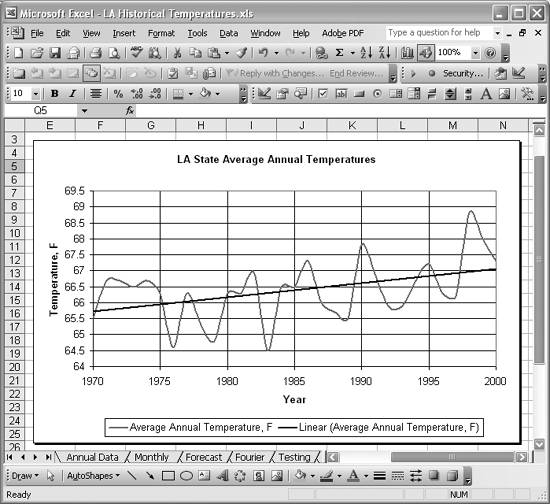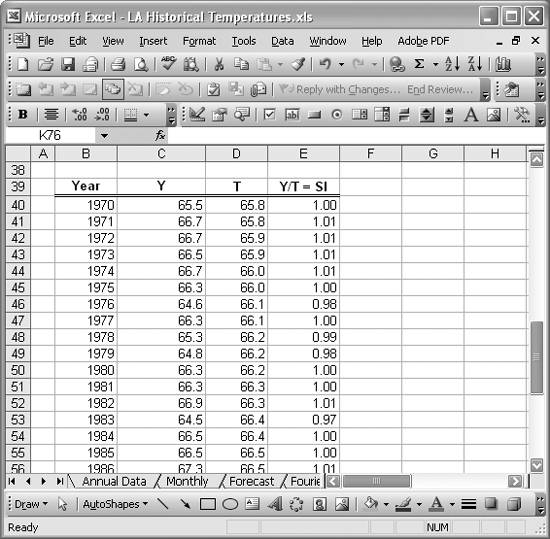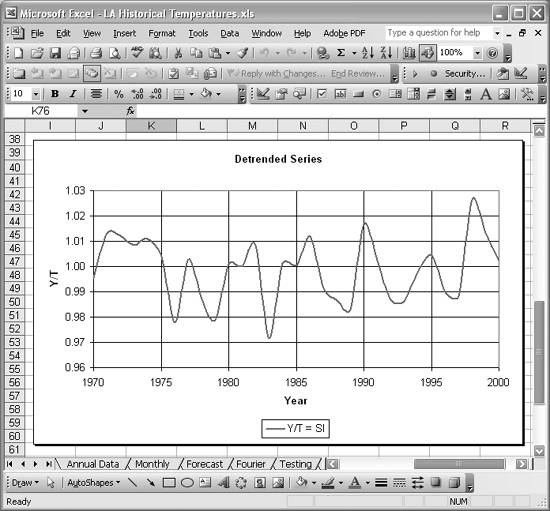Detrending a Time Series
Problem
You're working with a data series that exhibits a clear trend and before processing the data further you need to remove the trend from the data. This is called detrending .
Solution
Construct a trendline in Excel using one of the techniques discussed in Chapter 8 (see Recipe 6.2 for an introduction to trendlines in Excel). Use the resulting trendline to detrend the original data as discussed in this recipe.
Discussion
Time series data is often thought of as being comprised of several components: a long-term trend, seasonal variation, and irregular variations. (Some models assume a fourth, cyclic, component.) When analyzing time series data (e.g., when making forecasts based on historical data), it's often desirable to decompose the time series into its various components. To this end, additive or multiplicative models are often used.
Let Y represent the ordinates of a time series such that Y = f(t), where f is some function of time. Then, we can decompose Y as follows:

or

In these equations, T represents the long-term trend component, S the seasonal component, and I the irregular variation component of the total time series, Y. The first equation is a multiplicative model, while the second is an additive model. Which model you decide to use largely depends on the nature of your data and which model yields the best results. For example, when forecasting you might try both models and use whichever model yields the most accurate predictions. In this and the remaining recipes in this chapter, I'm going to use the multiplicative model; however, you can apply the additive model using very similar Excel techniques.
Figure 6-20 shows historical average annual temperatures for the state of Louisiana from 1970 to 2000. This series exhibits a clear upward trend, highlighted by the linear trendline superimposed over the original data.
Figure 6-20. Annual temperatures from 1970 to 2000

If you were going to make a forecast using this historical data, one of the first steps you'd take would be to detrend the original series to remove the long-term trend component.
Using the multiplicative model, divide both sides of the equation Y = TSI by T to yield Y/T = SI. This means the detrended series, Y/T, consists only of the seasonal and irregular variation components. To actually compute Y/T, you must first compute a trendline as shown in Figure 6-20 (see Recipe 6.2 or Chapter 8). Then compute the trend value for each year in the series. Next, divide the original series ordinate (Y) by the computed trend value (T) to yield the detrended series (SI). Figure 6-21 shows a portion of the spreadsheet I set up to perform these calculations for the example temperature series.
Figure 6-21. Detrending example spreadsheet

Column B contains the year while column C (under the heading Y), contains the original temperature series.
The formula for the trendline shown in Figure 6-20 is T=0.0446x-22.061, where x is the year. (This trendline equation was determined using Excel's chart trendline feature; see Recipe 6.2.) Column D (under the heading T), contains this formula for each year. The cell formulas in column D are of the form =0.0446*B40-22.061. This series represents the long-term trend component for the original time series.
Finally, column E (under the heading Y/T = SI), contains the detrended series. You simply divide each value in the Y column by the corresponding value in the T column to yield Y/T. The cell formulas in the Y/T = SI column are of the form =C40/D40. Figure 6-22 shows the resulting detrended series.
Figure 6-22. Detrended series

If you were to construct a linear trendline for this series, it would simply consist of a horizontal line. The variations shown in Figure 6-22 are around the long-term trend, and they consist of both seasonal components (if present) and irregular variations. Further analysis (e.g., when forecasting), would probably require you to decompose this series even further to remove the seasonal component. This process is called deseasonalization and is covered in the next two recipes.
See Also
There are other methods of detrending a time series besides using the least squares linear trendline used in this example. Sometimes higher-order trendlines are used, while at other times linear trendlines are computed using only the two series values at each end of the time series. Consult a standard text on time series analysis for more detailed information on these and other detrending methods.
Using Excel
- Introduction
- Navigating the Interface
- Entering Data
- Setting Cell Data Types
- Selecting More Than a Single Cell
- Entering Formulas
- Exploring the R1C1 Cell Reference Style
- Referring to More Than a Single Cell
- Understanding Operator Precedence
- Using Exponents in Formulas
- Exploring Functions
- Formatting Your Spreadsheets
- Defining Custom Format Styles
- Leveraging Copy, Cut, Paste, and Paste Special
- Using Cell Names (Like Programming Variables)
- Validating Data
- Taking Advantage of Macros
- Adding Comments and Equation Notes
- Getting Help
Getting Acquainted with Visual Basic for Applications
- Introduction
- Navigating the VBA Editor
- Writing Functions and Subroutines
- Working with Data Types
- Defining Variables
- Defining Constants
- Using Arrays
- Commenting Code
- Spanning Long Statements over Multiple Lines
- Using Conditional Statements
- Using Loops
- Debugging VBA Code
- Exploring VBAs Built-in Functions
- Exploring Excel Objects
- Creating Your Own Objects in VBA
- VBA Help
Collecting and Cleaning Up Data
- Introduction
- Importing Data from Text Files
- Importing Data from Delimited Text Files
- Importing Data Using Drag-and-Drop
- Importing Data from Access Databases
- Importing Data from Web Pages
- Parsing Data
- Removing Weird Characters from Imported Text
- Converting Units
- Sorting Data
- Filtering Data
- Looking Up Values in Tables
- Retrieving Data from XML Files
Charting
- Introduction
- Creating Simple Charts
- Exploring Chart Styles
- Formatting Charts
- Customizing Chart Axes
- Setting Log or Semilog Scales
- Using Multiple Axes
- Changing the Type of an Existing Chart
- Combining Chart Types
- Building 3D Surface Plots
- Preparing Contour Plots
- Annotating Charts
- Saving Custom Chart Types
- Copying Charts to Word
- Recipe 4-14. Displaying Error Bars
Statistical Analysis
- Introduction
- Computing Summary Statistics
- Plotting Frequency Distributions
- Calculating Confidence Intervals
- Correlating Data
- Ranking and Percentiles
- Performing Statistical Tests
- Conducting ANOVA
- Generating Random Numbers
- Sampling Data
Time Series Analysis
- Introduction
- Plotting Time Series Data
- Adding Trendlines
- Computing Moving Averages
- Smoothing Data Using Weighted Averages
- Centering Data
- Detrending a Time Series
- Estimating Seasonal Indices
- Deseasonalization of a Time Series
- Forecasting
- Applying Discrete Fourier Transforms
Mathematical Functions
- Introduction
- Using Summation Functions
- Delving into Division
- Mastering Multiplication
- Exploring Exponential and Logarithmic Functions
- Using Trigonometry Functions
- Seeing Signs
- Getting to the Root of Things
- Rounding and Truncating Numbers
- Converting Between Number Systems
- Manipulating Matrices
- Building Support for Vectors
- Using Spreadsheet Functions in VBA Code
- Dealing with Complex Numbers
Curve Fitting and Regression
- Introduction
- Performing Linear Curve Fitting Using Excel Charts
- Constructing Your Own Linear Fit Using Spreadsheet Functions
- Using a Single Spreadsheet Function for Linear Curve Fitting
- Performing Multiple Linear Regression
- Generating Nonlinear Curve Fits Using Excel Charts
- Fitting Nonlinear Curves Using Solver
- Assessing Goodness of Fit
- Computing Confidence Intervals
Solving Equations
- Introduction
- Finding Roots Graphically
- Solving Nonlinear Equations Iteratively
- Automating Tedious Problems with VBA
- Solving Linear Systems
- Tackling Nonlinear Systems of Equations
- Using Classical Methods for Solving Equations
Numerical Integration and Differentiation
- Introduction
- Integrating a Definite Integral
- Implementing the Trapezoidal Rule in VBA
- Computing the Center of an Area Using Numerical Integration
- Calculating the Second Moment of an Area
- Dealing with Double Integrals
- Numerical Differentiation
Solving Ordinary Differential Equations
- Introduction
- Solving First-Order Initial Value Problems
- Applying the Runge-Kutta Method to Second-Order Initial Value Problems
- Tackling Coupled Equations
- Shooting Boundary Value Problems
Solving Partial Differential Equations
- Introduction
- Leveraging Excel to Directly Solve Finite Difference Equations
- Recruiting Solver to Iteratively Solve Finite Difference Equations
- Solving Initial Value Problems
- Using Excel to Help Solve Problems Formulated Using the Finite Element Method
Performing Optimization Analyses in Excel
- Introduction
- Using Excel for Traditional Linear Programming
- Exploring Resource Allocation Optimization Problems
- Getting More Realistic Results with Integer Constraints
- Tackling Troublesome Problems
- Optimizing Engineering Design Problems
- Understanding Solver Reports
- Programming a Genetic Algorithm for Optimization
Introduction to Financial Calculations
- Introduction
- Computing Present Value
- Calculating Future Value
- Figuring Out Required Rate of Return
- Doubling Your Money
- Determining Monthly Payments
- Considering Cash Flow Alternatives
- Achieving a Certain Future Value
- Assessing Net Present Worth
- Estimating Rate of Return
- Solving Inverse Problems
- Figuring a Break-Even Point
Index
EAN: 2147483647
Pages: 206
